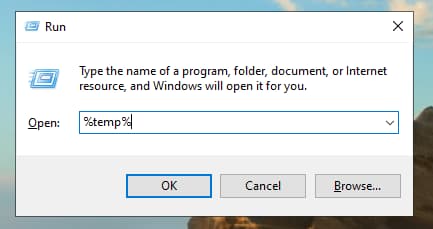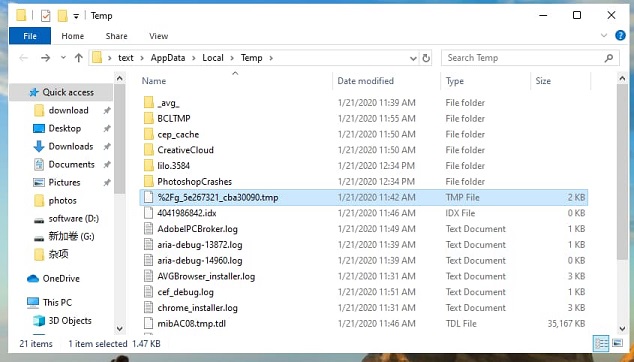How to Recover Temporary Files in Windows 10/7/XP/Vista
Quick Navigation:
- Part 1. How to Find the Temp Files in Windows 10
- Part 2. Recover Temp Files with Professional Software
- Step-by-step Guide for How to Recover Deleted/Lost/Temporary Files
- Step 1: Run Deep Data recovery
- Step 2: Specify the Location
- Step 3: Preview & restore temporary files in Windows 10/7/XP/Vista
Can temp files be recovered? This is a question that worries many users. Whether it is Word file or Excel sheet, you must know how to recover temporary files on your Windows system. But before we move on to the recovery part, let's learn a thing or two about temp files.
The temp files, saved with extension .tmp are the ones which are used by Windows for backup purpose. These files hold the content that is unsaved or edited in any file recently. The feature is provided so that in cases of abrupt malfunction in the system working, your lost files can be recovered. Sometimes, the temp files can't be found on the system, and you'll have to rely on third-party software for recovery.
So, here we will make an attempt to restore temporary files and get your files back as soon as possible.
Part 1. How to Find the Temp Files in Windows 10
Most of the temporary files are stored in the folder, which is called the Windows Temp folder. However, the location of the folder might differ from one system to another or even for different user's profiles. But you don't need to worry about finding the folder. In order to restore the temp file, you need to understand that once you close the program, the file gets erased. Plus, as the file stores a different type of data, it is hard to open the files without knowing what is inside it.
- Step 1: For Windows 10, use Cortana and open the Search box. For Windows 8.1, right-click on the Start button and choose the Run option. And for Windows 8.0, open the Apps screen and access Run. In the earlier versions of Windows, you can simply click on the Start button to open the Search box and find Run. In the Run window or search box, enter "%temp%" and hit the enter key. This command will open the designated temp folder on your system.
- Step 2: The default location of the folder is most likely to be- C:\Username\AppData\Local\Temp.
- Step 3: Inside the temp folder, you will find the files that are relevant for various apps that have been accessed recently.


To open a temp file, you first need to know that the file you are looking for, by default, have the app icon so that you can identify the type of temp file. Plus, temp files contain raw information. So, you have to be careful with them; otherwise, you'll end up losing the file permanently. In this way, you can recover temporary Word files, PowerPoint and more data in Windows PC.
In the above section, we know where we will find the temp files. As soon as you come across the relevant file, right-click on it and select "Open with" option.
You have to specify the app for the temp file in order to access the information stored in it. To convert the temp file into the desired file like Word, Excel, or PDF, you can rename the file according to the default extension of the apps, i.e., .docx, .xlsx, and .pdf.
The catch with restoring temp files is that it is not necessary that you will be able to find the file on your system.
Part 2. Recover Temp Files with Professional Software
Now that you know that temp files can also get lost, you might be panic. But there is no need as the Deep Data Recovery tool is here for your help. So, regardless of how and when you lost your files, the software can recover temp files on Windows 10 or any other Windows OS version. There are several reasons why data from your system might get lost, and this software is designed to recover everything in a seamless manner. Being a powerful and safe data recovery tool, you will be able to retrieve images, archives, videos, documents, etc. with one-click.
Your Safe & Effective Recover Temp File Software
- Recover deleted, lost and temporary files even without backup.
- Perform RAW drive recovery alongside other files lost due to an accident/intentionally deleted, system crash, virus attack, corrupted storage, and other unknown issues as well.
- A wide of file format support and device support with minimum requirements to use the software. It can restore files from partitions, hard drives, memory cards, digital cams, or any other storage device easily.
You can click this download link to get Recover Temp File Software now!!!
Step-by-step Guide for How to Recover Deleted/Lost/Temporary Files
Once you know how easy it is to restore tmp files from Windows, you won't even try any other option. So, just download the software on your system, and it will be ready for recovery right away. Here is the step-by-step guide that you can follow to get back the files you lost.
Step 1: Run Deep Data recovery
Launch the program and specify the type of data that is looking for. By default, all file types will be ticked; you can unselect the files as per requirement. Hit the Start button to initiate the process.

Step 2: Specify the Location
On the next screen, you will see the available space on the drive where the file could be found. Specify the location and press the Scan button on the top. The software will scan the entire drive space and display the results on the screen.

Step 3: Preview & restore temporary files in Windows 10/7/XP/Vista
Once the scan is finished, you can start looking for the files you want. Filter the results according to the file type and format. Then select the files, have a preview, and hit the "Recover" button.

Wait for a while, and you will have the temp files you need on your computer. And if the lost files are nowhere to be found, you still have the option for Deep Scan to find the lost data.
At last, we can assure you that using Deep Data Recovery is the optimal way for data retrieval. You will be able to recover the temp files without any delay or quality loss. What else do you want???
Related Articles
- How to Recover Deleted/Corrupted M4A Audio Files
- How to Recover Shift Deleted Files in Windows 10
- How to Recover Shift Deleted Photos in Windows 10/7
- Where Do I Find Autodesk VIZ Product Key from 2021-2005
If you are a software coordinator or contract manager, Autodesk Account provides serial numbers and product keys for all products. Read on how to find it! - 2022 Official Ways to Find Camtasia License Key: How to Find Camtasia Product Key
How to find Camtasia license key? Once you've to reinstall Camtasia to another device or occasionally format the existing partition or disk, this article can teach you how to find Camtasia product key. - How to Find Chrome Account and Password
If you are thinking how to find a chrome account and password, then this article is for you. We will discuss about two different ways through which we can find a chrome account and password.